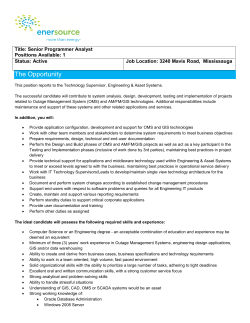
Reengineering Library Services with Emerging Technologies BY Devashri Shastri * and Pradipsinh Chudasma**
Reengineering Library Services with Emerging Technologies BY Devashri Shastri * and Pradipsinh Chudasma** *Librarian, Aadhrshila Knowledge Valley, Gandhinagar ** Library Assistant, Institute of Technology, Nirma University Date: March 21-23, 2013. 1 Objectives: To understand and analyze structure and utility value of new technologies in the library scenario. To find out technological challenges and areas of application of emerging technology in the automated library system. To evaluate application of technological services with their advantages and disadvantages. 2 INTRODUCTION: Libraries and Information centers have to evolve measures continuously to keep up with the changing requirements of their patrons. The father of library science in India, Dr. S. R. Ranganathan’ s philosophy reflects “Right information” to the “Right user” in a “Right Personal way” at a “Right time” in his pioneer work “Five Laws of Library Science.” Due to information explosion and information pollution knowledge professionals and librarians are facing many challenges. ICT, Internet and library automation softwares made it possible for users to locate what they want without going to library and fulfill their needs. 3 EMERGING TECHNOLOGIES IN THE LIBRARY SCENARIO: MOBILE TECHNOLOGY CLOUD COMPUTING GIS (Geographic Information System) INTERNET BASED LIBRARY SERVICES DIGITAL REFERENCE SERVICE: SYNCHRONOUS REFERENCE SERVICE ASYNCHRONOUS REFERENCE SERVICE CONSORTIA BASED SERVICES 4 APPLICATION OF MOBILE TECHNOLOGY IN LIBRARY SCENARIO 5 MOBILE BASED LIBRARY AND INFORMATION SERVICES: User orientation programmes Upcoming Events Information literacy programs New Arrivals / Book Reservation Circulate significant circulars of library and institute Renewals notification alert Due and overdue documents messages OCLC Released it 6 LIBRARY AND MOBILE TECHNOLOGY: 7 APPLICATION OF CLOUD COMPUTING IN THE LIBRARY SCENARIO 8 CLOUD COMPUTING AND LIBRARY: • Definition of Cloud Computing: Cloud is a virtualization of resources and services that maintains itself and in cloud computing, distributed, grid and utility computing combined to perform functions with dynamically changing requirements. Resources like software, hardware and platform are provided on demand as well as it is a secure, reliable data storage center. 9 CLOUD SERVICE MODEL : Platform as a Service (PaaS) Software as a Service (SaaS) Infrastructure as a Service (IaaS) 10 PLATFORM AS A SERVICE (PAAS) • Build web-applications and deploy application without installing any tool or their system advantage: Simplified deployment, lower risk, pay-peruse model and scalability Disadvantage: some applications are local and some are in cloud so increased complexity 11 SOFTWARE AS A SERVICE (SAAS) Benefits: Install, run and maintain software Service delivered through the browser and no expert team is required Provide this service by downloading the application for customers Host the application on the web server either on contract basis or on the basis of license agreements. 12 INFRASTRUCTURE AS A SERVICE (IAAS) Libraries can share hardware and other computing resources, so the cost of server and maintenance will be saved. Examples of IaaS providers : ServePath’s GoGrid Skytap’s Skytap virtual lab 3 tera’s Amazon’s Elastic Compute Cloud AT &T, IBM & Unisys, Gni’s GNi Dedicated Hosting, and IBM’s Computing on Demand 13 CLOUD COMPUTING FEATURES: cost-effectiveness security scalability versatility virtualization user-friendliness scalability and resource optimization 14 CLOUD BASED SERVICES Google Apps Service World Wide Web RSS Feeds Remote Access Facility Collaborating online Databases Collaborative Virtual Reference Service (CVRS) IM, IR, Online Streaming, Blogs, Wikis 15 PROBLEM SOLVED BY CLOUD COMPUTING: IT infrastructure Shortage of I. T. experts Financial problems Data integrity Upgrade and Maintenance Intellectual Property Rights Management related issues Backups 16 APPLICATION OF GIS SOFTWARE IN LIBRARY SCENARIO 17 HISTORICAL BACKGROUND: Tomlinson (1998), the leader of Canadian Geographic Information System, coined the term ‘Geographic Information System’ in the early 1960s to refer to any computer application that perform functions with geospatial data (data related to space). • 1960 – 70s Innovation First GIS – Canada Land Inventory DIME US Bureau of Census Harvard Laboratory for Computer Graphics Major vendors started (e.g. ESRI, Intergraph) Landsat satellite launched Key academic conferences (e.g. AutoCarto) 18 DEFINITION OF GIS: A Geographical Information System is a tool, which can accept large volumes of spatial data derived from a variety of sources, retrieve, manipulate, analyze and display them according to user-defined specifications. It brings together the ideas developed in various fields such as Computer Science, Civil Engineering, Mathematics, Surveying, Economics, Agriculture and Geography to name a few. 19 SELECTED DEFINITIONS OF GIS: Aronoff (1989) - Any manual or computer based set of procedures used to store and manipulate geographically referenced data Dueker (1979) - A special case of information systems where the database consists of observations on spatially distributed features, activities, or events, which are definable in space as points, lines, or areas. A GIS manipulates data about these points, lines and areas to retrieve data for adhoc queries and analyses. DoE (1987) - A system for capturing, storing, checking, manipulating, analyzing and displaying data which are spatially referenced to the Earth. Carter (1989) - An institutional entity, reflecting an organizational structure that integrates technology with a database, expertise and continuing financial support over time. Parker (1988) - An information technology which stores, analyses, and displays both spatial and non-spatial data. Geographic Information System consists of: GIS is Organized collection of Software People Hardware Data Software People Network Data Procedures Network Procedures Hardware 21 • • • • Key Components of GIS: Hardware High end workstations to desktop systems Software Geo processing engine of GIS Major Functions – collect, store, process, manage, analyse and presentation of data. GIS data base (spatial and related data) Live ware People are responsible for designing, implementation and using GIS 22 WHERE IS A GIS FROM ? Geography, Cartography Remote Sensing and space technology Computer Aided Design (CAD) and computer graphics Surveying and photogrammetry 23 TYPES OF INFORMATION SYSTEMS: Transaction Processing Systems Decision Support System (DSS) GIS belongs to second type that is Decision Support System (DSS), used for resource planning, data manipulation, analysis and formation of modeling to provide guidance to decision makers. 24 • • • SPECIAL FEATURES OF GIS: GIS basically handles two kinds of data: Spatial data also referred as geographic co-ordinate data (records point, line, area) and another is, Attribute data, information related with particular geographical feature. It is Multidimensional and Voluminous. Requires projection to flat surface and use unique analysis methods. 25 • • Analyses require data integration and data updates are expensive and time consuming, GIS can solve this problem. Map displays require fast data retrieval. 26 GIS industry is worth around $13 billion: Software • Services • Data • Publishing • Education 27 • • Global Positioning System (GPS) and GIS: Contribution of GPS to the development of bases is very significant. GIS data Global Positioning System (GPS) is a satellite based navigation and surveying system for determining precise position and time using radio signals from satellites in real time or in post processing mode. Mainly GPS is used for determining the coordinates of important geographical features, precise cadastral surveys, vehicle navigation and on highways using GPS-GIS integrated systems. 28 GIS SOFTWARE CLASSIFICATION: Type Software Type ofof Software SystemSystem Professional Professional Desktop Desktop Hand-held Hand-held Component Component Viewer Viewer Internet Internet 0 0 1000000 2000000 1000000 Users 2000000 3000000 3000000 Users 29 POPULAR PROPRIETARY GIS SOFTWARES: Esri– Products include ArcView 3.x, ArcGIS, ArcSDE, ArcIMS, ArcWeb services and ArcGIS Server. IGiS MapInfo Intergraph Autodesk SuperMap Inc. 30 SOME POPULAR FOSS GIS SOFTWARES: TerraView TatukGIS GRASS GIS SAGA GIS Quantum GIS (QGIS) uDig JUMP GIS / OpenJUMP ((Open) Java Unified Mapping Platform) –The desktop GISs, OpenJUMP, SkyJUMP, deeJUMP and Kosmo all emerged from JUMP. 31 FOSS SOFTWARE PLATFORM & FEATURES TerraView Windows, Linux, Handles vector and raster data stored in a relational or geo-relational database, i.e. a frontend for TerraLib. TatukGIS Windows (XP, Vista, 7, 8 and Server 2003, 2008 & 2012). System requirements same as for the Windows operating system MapWindow GIS Windows, Free desktop application and programming component. GRASS GIS Windows, Max OS X, Linux, BSD, Unix, Originally developed by the U.S. Army Corps of Engineers: a complete GIS. 32 FOSS SOFTWARE PLATFORM & FEATURES SAGA GIS (System for Automated Geoscientific Analysis) Windows, Linux, Free BSD, A hybrid GIS software, has a unique Application Programming Interface (API) and a fast growing set of geoscientific methods, bundled in exchangeable Module Libraries. Quantum GIS (QGIS) Runs on LINUX, UNIX, Mac OS X and Windows. uDig LINUX, UNIX, Mac OS X and Windows, API and source code (Java) available JUMP GIS / Open JUMP ((Open) Java Unified Mapping Platform) - JAVA base, The desktop GISs, OpenJUMP, SkyJUMP, deeJUMP and Kosmo all emerged from JUMP. 33 GIS TECHNOLOGY AND LIBRARY: The significant steps involved in application of GIS in libraries are drawing library building map, floor maps and designing the database, developers can take help of AutoCAD for preparing accurate architectural layout of library building. For a multi-storied library building GIS technology can be applied. Nowadays Global Position Systems (GPS) and web-based mapping applications like Google Maps are also play active role, LIS research will also continue to organize and disseminate geospatial data. 34 AREAS OF APPLICATION OF GIS IN THE LIBRARY: USER EDUCATION SYSTEMATIC SHELVING MODEL DETAILS ABOUT LOCATION OF LIBRARY USERS MAPPING OF BOOK SUPPLIERS AND DISTRIBUTORS ASSISTS TO FIND LOCATION OF PARTICULAR DOCUMENT ON RACK THROUGH MAP FORM VIRTUAL LIBRARY NETWORK 35 Advantages of FOSS GIS: One can visualized information spatially using map and images, not only a bunch of data inside table. Good support of open standards and unrestricted use of the software. Customization at API level. No loss of support to a particular programming language, source codes freely Available. 36 • • FOSS GIS Disadvantages: Know-how on installing the software may be needed, but with some time spend on the net plenty of advice will be available. FOSS GIS have some limitations while compared with powerful proprietary GIS softwares (proprietary GIS softwares are coastly) such as ArcView or ArcGIS especially FOSS GIS are unable to create automating labeling and usually proprietary softwares are better in terms of support for various projection, navigation and coordinating systems. • Training costs may be high • New projects may have initial starting troubles • Application of GIS in library is resource intensive as well as too much amount of data needed to enter in the beginning. 37 LIBRARY MAP FROM ARC VIEW GIS 3.2: 38 Image of library books - status using GIS : 39 INTERNET BASED INFORMATION SERVICES AND INFORMATION MANAGEMENT: Search Engines : Alta Vista, Hot Bot, Lycos, Infoseek, Excite… Multithread Search Engines: Metacrawler and Dogpile E-resources : E-books, e-Journals, IR, Information Portals Subject Directories Listeserves Webinars 40 LIBRARY AUTOMATION: LMS: Koha, NewGenLib, OpenBiblio, Evergreen, PhpmyLibrary, GNU Library Management System and Libsys CMS : Drupal, Jumala, Wordpress, Mambo, Typo3 IR : Dspace, Fedora Commons, CDSware, Eprint, Ganesha, XTF, VuDL Synchronous Digital Reference Services Asynchronous Digital Reference Services 41 INFORMATION MANAGEMENT: • Blogs • Tagging • Folksonomy • Podcast Prove useful for creating, sharing and distributing information in library scenario. 42 Role of Consortia: Some significant consortia in India are: Government funded consortium (National Knowledge Resource Consortium), INDEST-AICTE consortium (open consortia, funded by MHRD), UGC-INFONET (funded by UGC), CeRA, HELINET, ERMED consortium and many voluntary consortia like FORSA. IIM Libraries… There is need to emphasis conference papers, research articles etc. along with other e-journals and e-books. 43 Conclusion: With the help of technological advances, library and knowledge professionals need to redesign library services to support learning, teaching, research, and other developmental activities. To provide virtual and digital library services via technologies such as Cloud computing and GIS, high bandwidth is required so country wide strong I. T. infrastructure is pre-requisite. GIS platform in the library opens many new gateways and provides several opportunities to the libraries for contributing their share in planning and decision making in the area of handling geographic information, 44 which they did not avail earlier. The system is quiet expensive, especially the GIS software. But, nowadays there's development of open source GIS that able to overcome this problem. 46
© Copyright 2025









